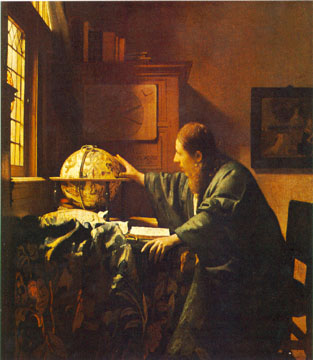
Key points: Impact of new technology on astronomy; value of accurate, homogeneous observations
| As Europeans emerged from the "Dark Ages," their technical skills improved. This painting of an astronomer (by Vermeer) shows the progress. The astronomer is looking at a book and an accurately rendered celestial globe, made by Jodocus Hondius in 1600. On the table, on a rich oriental tapestry, is an astrolabe, precursor of the large instruments developed by Tycho Brahe to measure planetary positions. ("The Astronomer," by Vermeer, from Roy Williams, http://www.cacr.caltech.edu/~roy/vermeer/ucy.html) |  |
 |
Tycho Brahe, a Dane,
worked from ~ 1570 - 1601 and built the most accurate naked eye
observatory ever. To the right, he is in discussion with his
patron Rudolf II (seated).
(to left, From A. Van Helden http://es.rice.edu/ES/humsoc/Galileo/People/tycho_brahe.html) to right from Eduard Ender http://www.mathsyear2000.org/museum/floor4/gallery11/gal11_p4.html |
 |
 |
Tycho had huge instruments made to high accuracy to allow observers to sight positions accurately (originally from Landskrone official Tycho website http://www.landskrona.se/kultur/tychobrahe/, now at http://www.tychobrahe.com/en/ ) and Astronomy, by Fred Hoyle). He was able to measure angles and hence positions of stars to an accuracy approaching 1 arcmin, equivalent to 1/30 the diameter of the full moon. |  |
In addition, the first reasonably accurate clocks had been invented a few decades earlier and helped solve the age-old problem of relating observations to correct time.
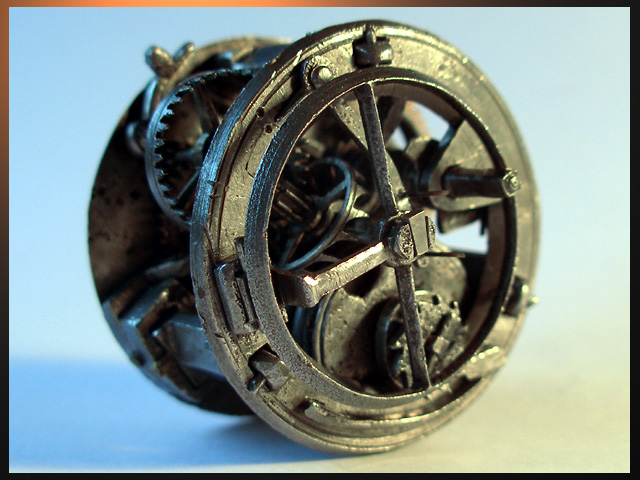 |
Spring-Powered Clock by Peter Henlein, ~ 1530, from http://www.peterhenlein.com/ |
In addition to making observations of unprecedented accuracy, Tycho also developed the concept of attaching an uncertainty to each of his measurements -- he would give a value and then state by what amount it could be wrong. This innovation made it possible to judge whether a model's disagreement with an observation is significant or not. See http://www.nada.kth.se/~fred/tycho/index.html and http://www.tychobrahe.com/UK/om_tycho.html for more about this strong personality.
Tycho observed the planets over a long number of years, and hoped to solve the problem of exactly how they move. He vehemently rejected the Copernican model because he had no sense that the earth moved and, more importantly, he could not detect parallax in his observations. He proposed a variant in which the earth is fixed, the moon and sun orbit it, and all the other planets orbit the sun. He made no effort to calculate planetary positions from his model to compare with his data.
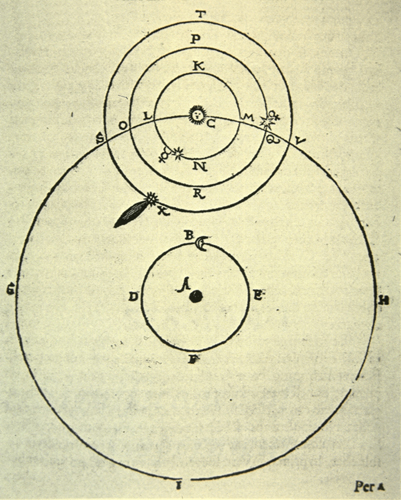 |
Tycho's drawing to the left.. Mercury and Venus (and a comet) orbit the sun, marked with C and whose orbit is labeled "SOL". The sun and the moon orbit the earth (from Landskrone official Tycho website http://www.landskrona.se/kultur/tychobrahe/ and http://www.uky.edu/~engjlg/research/brahe.htm.) |
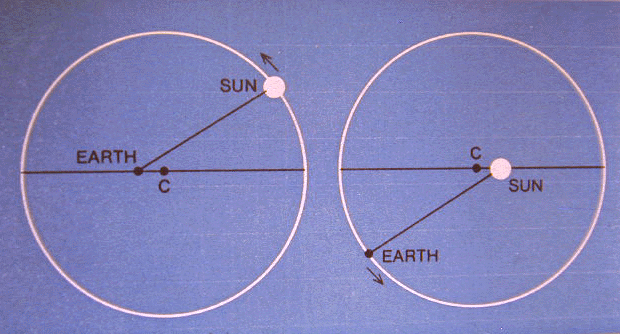 |
Tycho's model is geometrically identical to Copernicus's!! It is just a matter of changing the definition of what is fixed -- the sun or the earth. (Scientific American) |
|
|
| Tycho's careful observations of the great comet of 1577 established that it (and presumably all comets) was above the atmosphere and part of the solar system. Here is a Turkish painting of the comet to the left and a woodcut made in Prague to the right. (from http://ase.tufts.edu/astroweb/print_images.asp?id=14 and Erol Pakin, Director, Istanbul Universitesi Rektorlugu and from the Intitut fur Planetforschung, http://berlinadmin.dlr.de/Missions/corot/caesp/comet.shtml) | |
| Another important event during Tycho's career was the explosion of a nearby star into a supernova. This event shattered the dogma that the heavens were unchanging. (From Flammarion's Astronomie Populaire (1880), reproduced in Sky and Telescope, November 1998 http://physics.weber.edu/carroll/honors/tychosn.htm) | |
 Case for Copernicus' working copy of his book
on the solar system http://www.bj.uj.edu.pl/bjmanus/revol/titlpg_e.html Case for Copernicus' working copy of his book
on the solar system http://www.bj.uj.edu.pl/bjmanus/revol/titlpg_e.html |
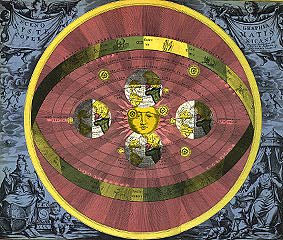
Kepler's system has the sun at the center and all the planets orbiting it, from http://www.umich.edu/~iinet/crees/regionalstudies/polish/wodiczko_lecture.htm) |
|
Click to return to syllabus |
||
| Click to return to Copernicus | hypertext |
Click for Kepler |